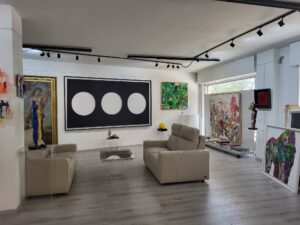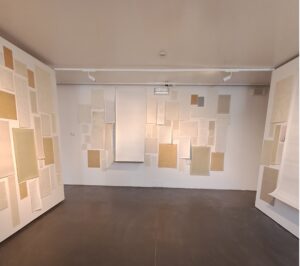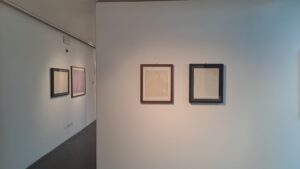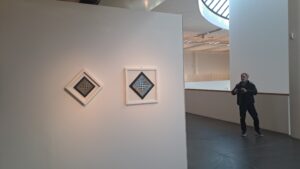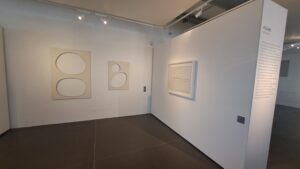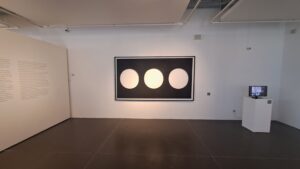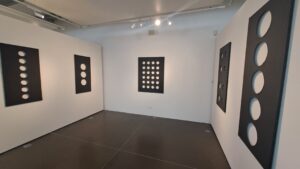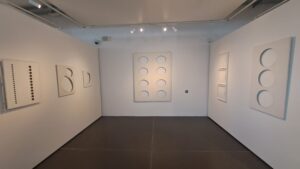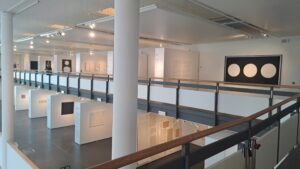Dadamaino (Edoarda Emilia Maino) was born in Milan in 1930. During the bombings of the Second World War the Maino family moved to La Maddalena, a hamlet of Somma Lombardo (VA), where her maternal grandparents lived, and then returned to Milan at the end of conflict. There Edoarda will attend the Classical High School and subsequently the School of Art Applied to Industry of the Castello Sforzesco.
Her training took place through frequenting the Milanese avant-garde whose meeting point was the Bar Giamaica in Brera: she was especially close to Piero Manzoni, who she had frequented since 1957, and to Lucio Fontana, who profoundly influenced her research. In the 1960s his work underwent a phase of important internationalization with strong connections with the research groups Nul, Zero, Nouvelle Tendance and GRAV (Groupe de Recherche d’Art Visuel). In the Seventies, Dadamaino’s activity was strongly influenced by the political commitment of the period, with numerous personal exhibitions and participation in collective exhibitions in museums and institutional spaces in Italy and abroad. In 1980 he was present with a personal room at the XXXIX Venice Art Biennale with 461 sheets of The Facts of Life, and in 1990 he returned to the XLIV Venice Art Biennale curated by L. Cherubini, F. Gualdoni, L. Virgin with two monumental works from the cycle Il Movimento delle cose.
.. 2023/2024 ..

An exhibition on Dadamaino is organized in the magnificent spaces of the MA*GA Museum in Gallarate, in collaboration with Archivio Opera Dadamaino, with the support of Galleria Arte Martinelli
The retrospective dedicated to Dadamaino (Edoarda Emilia Maino, 1930-2004) retraces the fundamental stages of the artistic career of one of the major protagonists of the avant-garde of the second half of the twentieth century, from the investigation into monochrome painting and the surface of the canvas in the late 1950s, until the international recognition of the Sixties and the participation in two fundamental International Art Exhibitions of the Venice Biennale, in 1980 with a personal room curated by Vittorio Fagone in which he exhibited The Facts of Life, and in 1990 with two works from the cycle The movement of things, invited by Laura Cherubini, Flaminio Gualdoni and Lea Vergine, both exhibited in the exhibition.
The exhibition itinerary opens with the Volumes of the late fifties, in which the rejection of the traditional pictorial practice that will accompany him throughout his creative parable is immediately evident, and continues respecting Dadamaino’s research method which moves through homogeneous series , very distinct and characterized including, after the Volumes (1958-1960), the Volumes with staggered modules (1960-1961), the Rilievi (1961), the Optical-dynamic objects (1962-1965), the Componibili (1965- 1966), The search for colour (1967-1968), Public Art and the Environments project (1969), the Cromorilievi (1972), The Rational Unconscious (1975), The Alphabet of the mind (1977), I facts of life (1978-82), the Constellations (1981-1987), The Movement of Things (1981-1987).
The attention to Dadamaino’s work is also an opportunity for the Museum to reflect on its own history intertwined with that of the City of Gallarate National Visual Arts Award which, through important exhibition opportunities, has allowed it to build a collection of great value focused on Italian artists.
In 1976 Dadamaino participated with two works in the second exhibition of the 10th edition of the National Visual Arts Award for the city of Gallarate, Art of scientific and technological inspiration, invited by Umbro Apollonio. On this occasion the artistic commission rewards and purchases the work Volume a modules staggered from 1960 which officially enters the collection of the Civic Gallery of Modern Art, now MA*GA. Alongside her, many artists exhibited who in the current and previous decades had shared participation in groups and trends, the search for experimental languages, the cultural and personal struggles for the renewal of the arts in Italy.
For this reason, in the exhibition Dadamaino’s works dialogue with the works of the MA*GA collection by Lucio Fontana, mentor of many young artists, Enrico Castellani and Piero Manzoni, Davide Boriani, Bruno Munari, Getulio Alviani, Gianni Colombo, Nanda Vigo and Grazia Varisco to fully revive the cultural fervor of those years.
